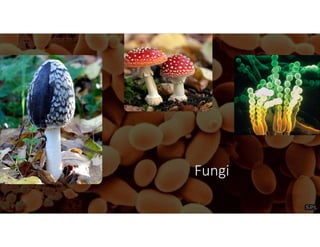
Fungi Lab PPT.pdf
- 1. Fungi
- 2. Kingdom Fungi • A unique group of organisms that are heterotrophic by absorptive means • Secrete enzymes across their cell wall and absorb smaller organic compounds
- 3. Kingdom fungi • Eukaryotic, multicellular, absorptive heterotroph • Decomposers • Fungi secrete enzymes that break down organic matter outside their bodies; They then absorb the nutrients. • Cell walls made of CHITIN • Classified based on the presence and types of sexual structures
- 4. Kingdom Fungi Two Types Saprotrophs/saprophyte: feed on dead matter Parasites: feed on the tissues of other animals or plants - athletes foot - ringworm - thrush
- 5. Ecological significance • Some fungi are harmful, but many are beneficial • Decomposers—break down dead plants and animals and return inorganic nutrients back to plants; Fungi in the forest that decay wood play an important role in the carbon cycle • Food source • Fermentation by yeasts—baking bread, brewing beer, making wine
- 6. Fungal Phylogeny Movement onto land Chytrids (1,000 species) Zygomycetes (1,000 species) Glomeromycetes (160 species) Ascomycetes (65,000 species) Basidiomycetes (30,000 species) Hyphae 25 m 25 m Fungal hypha
- 7. Fungal diversity • 5 phyla • Chytridiomycota—swimming spores—have flagella • Ascomycota—spores in sacs—make antibiotics • Basidiomycota—spores on club-like structures— mushrooms and club fungi • Glomeromycota—no sexual spores—symbiosis with plants • Zygomycota—zygospores—bread mold, Rhizopus
- 8. Fungal Anatomy Chitin: cell walls of fungi are reinforced with this major support compound Spores: reproductive structure of fungi
- 10. All fungal bodies are made of hyphae forming a mass called the Mycelium
- 11. Mycelium-a mass of hyphae
- 12. Nutritional Mode: Heterotrophs nutrients Extracellular Digestion
- 14. Terminology Sporocarp – Fruiting body of the fungus that produces the spores. • Each of the phyla are distinguish by the types of spores and sporocarps Basidocarp Ascocarp Zygomycota
- 15. Chytridomycota (Chytrids) • Thought to be the most ancient group • Once grouped within Protista • Aquatic • Zoospores: flagellated spores • Asexual or sexual • Parasitize protists, plants, and animals
- 16. Zygomycota (Zygote Fungi) • Considered the 1st fungi to colonize terrestrial habitats • Can reproduce sexually or asexually • Asexual reproduction occurs through sporangiospores
- 17. Zygomycota (zygomycetes) • Most common method of reproduction is with ball like sporangia which produce spores through meiosis • Commonly called mold • Rhizopus (genus)
- 19. Basidiomycota (Club Fungi) • Mushrooms, Shelf Fungi, Puffballs, Rusts • Long lived mycelium stage • Sexual reproduction: • Occurs in the fruiting body known as the basidiocarp • Produces basidiospores • Contains mychorrizae
- 20. Basidiomycota (Club Fungi) The massive amounts of hyphae/mycelium can obtain lots of energy, so quick production of the fruiting bodies occurs in optimal conditions
- 21. Basidiomycota (basidiomycetes) • Sexually basidiospores on club-shaped hyphae • Largest and most conspicuous • Mushrooms, toadstools, shelf fungi, puff ball fungi • Decompose wood/plant material
- 23. Anatomy of a typical Basidiomycota (Mushroom) Cap Gills Stalk
- 24. Shelf Fungus
- 25. Amanita
- 26. Fairy Rings
- 27. Ascomycota (Sac Fungi) • Can reproduce sexually and asexually • Asci: • Saclike structure that produces sexual spores • Ascocarps: • Fruiting bodies where the asci are found • Conidia: • Spores produced by specialized hyphae that allow for asexual reproduction
- 28. Ascomycota (ascomycetes) • Sexually ascospores in ascocarps; “sac fungi” Yeasts Morels Truffles
- 29. Ascomycota (ascomycetes) Also called “sac fungi” Asci- usually contain 8 ascospores, produces by meiosis Hymenium
- 30. Mychorrizae (Not a taxonomic group) • Symbiosis • Mutualism with Basidiomycota • Enhance the nutrient absorption of plant roots w/ extensive hyphae. • Fungi receives organic nutrients synthesized by the plant
- 31. Lichens (Not a taxonomic group) • Symbiotic relationship between a fungus (usually Ascomycete) and photosynthetic cell (either an algae or cyanobacteria) • Fungus houses algae and collects nutrients, in return uses some of the energy produced by photosynthesis
- 32. Lichen Anatomy
- 33. Lichens 3 types: crustose: looks like crust on tree bark foliose: looks like leaf material on bark fruticose: look like miniature shrubs
- 34. Lichen: Foliose
- 37. 3 types of lichens on the same tree
- 38. Today’s lab • Look at representatives of different phyla from the fungi kingdom • Understand the differences between the phyla • Be able to identify different parts of fungal anatomy